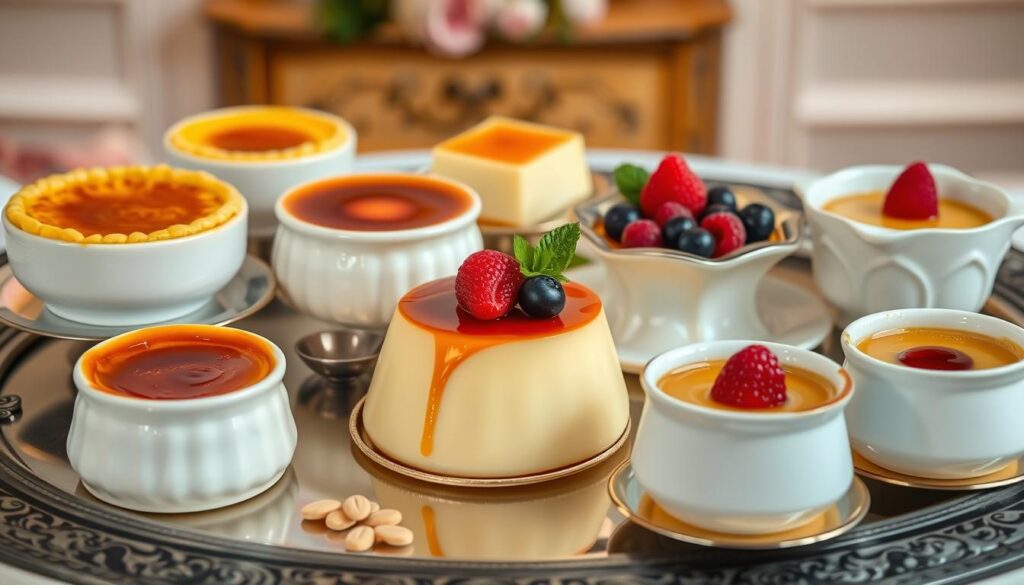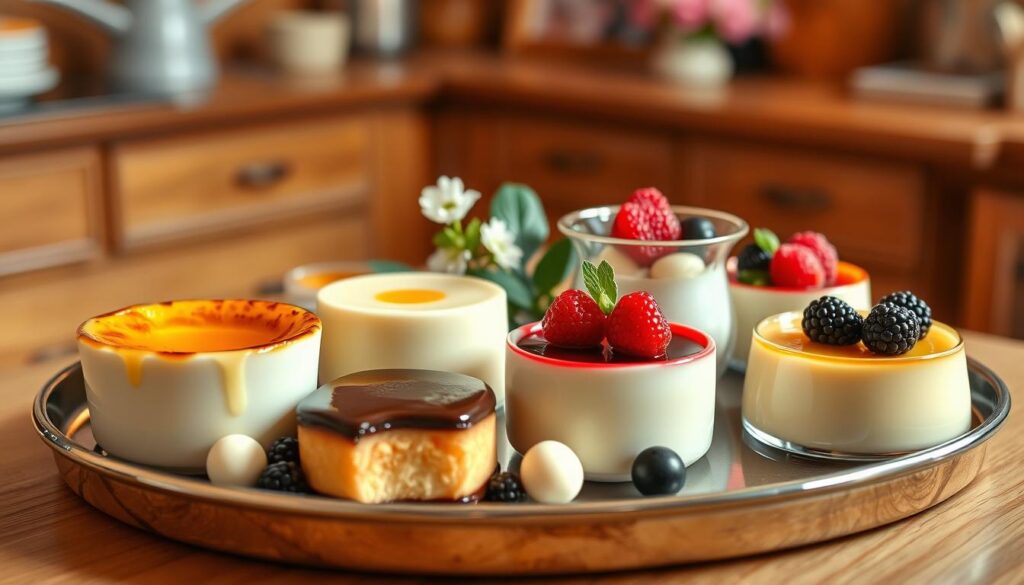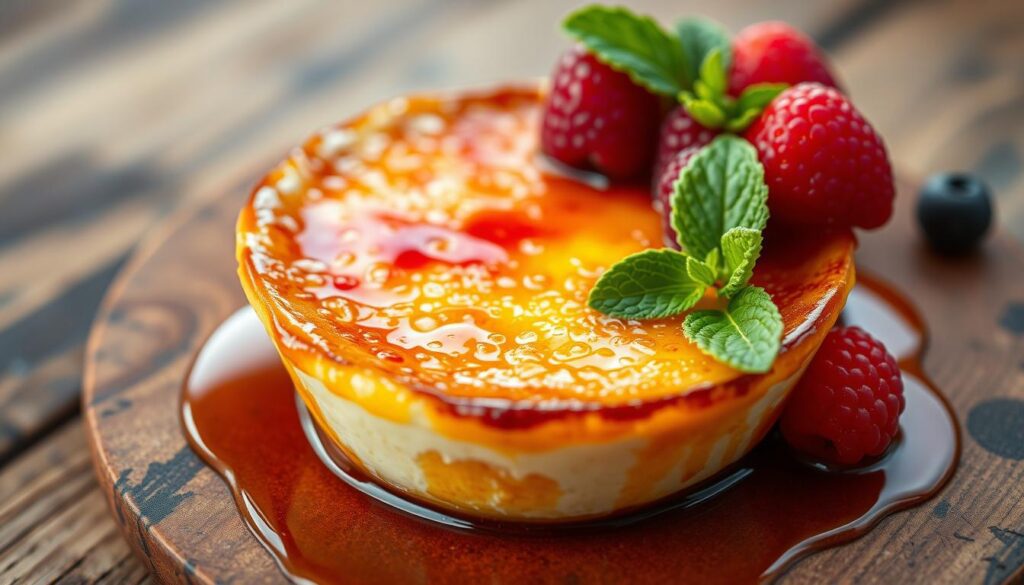Crème brûlée is a favorite dessert known for its creamy texture and caramelized sugar. It’s a French treat that has become a symbol of luxury. But it’s not alone in its creamy goodness. This article dives into the world of custard-based sweets, showing how crème brûlée stands out and its closest relatives.

Key Takeaways
- Custard-based desserts rely on a balance of eggs, sugar, and dairy for their distinctive textures and flavors.
- Crème brûlée shares similarities with other egg-thickened custards like pots de crème and flan.
- The signature caramelized sugar topping is what sets crème brûlée apart from its custard-based counterparts.
- Crème brûlée has gained widespread popularity in the United States, becoming a symbol of indulgence and luxury.
- Proper temperature control and preparation techniques are crucial for achieving the perfect crème brûlée.
Understanding the Basics of Custard-Based Desserts
Custard-based desserts are loved for their creamy texture. They have been a favorite for centuries. The key ingredients are egg yolks and heavy cream. How much of each affects the custard’s texture and taste.
The Role of Eggs and Cream in Custards
Egg yolks make custard silky and smooth. Heavy cream adds a rich, indulgent feel. Together, they create a range of textures, from crème anglaise to pastry cream.
Different Types of Custard Textures
- Crème anglaise (pouring custard): A thin, pourable custard with a rich, silky mouthfeel.
- Pastry cream (crème pâtissière): A thicker custard used as a filling for desserts like éclairs and cakes.
- Bavarian cream (bavarois): A custard-based dessert set in molds, featuring a creamy, airy texture.
- Crème mousseline: A richer version of diplomat cream, incorporating butter and praline for a decadent experience.
Common Custard Preparation Methods
There are many ways to make custard-based desserts. Baking in ramekins or a water bath makes it creamy. Stovetop methods, like stirred custard, make it silkier.
Learning about custard desserts opens up a world of flavors. From crème brûlée to Watalappan, there’s so much to explore. Mastering eggs, cream, and cooking techniques lets you create amazing desserts.

| Custard Type | Key Ingredients | Texture | Common Applications |
|---|---|---|---|
| Crème anglaise | Milk, cream, egg yolks, sugar | Thin, pourable | Ice cream, pouring custard |
| Pastry cream | Milk, egg yolks, sugar, cornstarch | Thick, stable | Éclairs, cakes, tarts |
| Bavarian cream | Crème anglaise, whipped cream, gelatin | Creamy, airy | Molded desserts |
| Crème mousseline | Crème pâtissière, whipped cream, butter, praline | Rich, smooth | Cakes, fillings |
What is Crème Brûlée Similar To?
Crème brûlée is a rich custard dessert with a caramelized sugar topping. It’s similar to crème caramel and flan. But, crème brûlée has its own special qualities.
Crème caramel is like crème brûlée but has a lighter texture. It uses whole eggs and a mix of milk and cream. The caramel on top is thinner and more spread out than crème brûlée’s.
Flan is also similar to crème caramel. But, it can be different depending on where it’s from. Some flans are firmer, while others are creamy like crème caramel.
| Dessert | Custard Base | Topping | Texture |
|---|---|---|---|
| Crème Brûlée | Egg yolks, cream | Caramelized sugar | Rich, dense |
| Crème Caramel | Whole eggs, milk and cream | Thin caramel layer | Light, delicate |
| Flan | Varies by region | Caramel sauce | Custard-like, can vary |
Even though these desserts are similar, crème brûlée is special. It has a thick custard and a crunchy caramel topping. This makes it a unique and indulgent treat.

The Distinct Characteristics of Crème Brûlée
Crème brûlée is a French dessert loved for its mix of textures and tastes. It has a creamy custard base topped with a torched sugar layer. This layer cracks when you bite into it, adding a special touch.
The Signature Caramelized Top Layer
The top layer of crème brûlée is what makes it stand out. It’s made by torching the custard’s surface. This creates a crunchy torched sugar layer over a smooth custard base.
Rich and Creamy Base Components
The base of crème brûlée is made with heavy cream and egg yolks. This mix makes it thick and creamy. It’s so creamy and rich, it’s almost like a treat for your taste buds.
“Crème brûlée is a symphony of contrasting textures and flavors, with its caramelized crust and rich, creamy custard base.”
Comparing Crème Brûlée and Crème Caramel
Crème brûlée and crème caramel may look similar, but they are quite different. They have unique ways of making, textures, and tastes. Knowing these differences helps us enjoy each dessert’s special qualities.
Crème caramel, also known as “flan” or “crème renversée,” is made in a caramel-lined dish. It’s then turned over onto a plate when served. This makes a creamy custard with caramel sauce at the bottom. On the other hand, crème brûlée has a thick custard topped with a crunchy caramel layer.
| Crème Brûlée | Crème Caramel |
|---|---|
| Richer custard base due to higher egg yolk and cream content | Firmer texture that can hold its shape when unmolded, using a mix of whole eggs and milk/cream |
| Signature caramelized sugar top layer that provides a satisfying crunch | Caramel sauce at the bottom of the custard, providing a sweet, gooey contrast |
| Typically served chilled, with the custard base set and the caramel top crisp | Often served at room temperature or slightly chilled, allowing the custard to be soft and creamy |
Both desserts start with a custard base, but their making and ingredients make them different. Crème brûlée is rich and creamy, with a crunchy caramel top. Crème caramel is smooth, with caramel sauce at the bottom, offering a balanced sweetness.
Essential Ingredients for Perfect Crème Brûlée
Crème brûlée is a French dessert loved for its creamy custard and caramelized sugar. The caramelized layer is famous, but the dessert’s success comes from its ingredients.
The Importance of Heavy Cream
High-quality heavy cream is key to a great crème brûlée. It has at least 36% milk fat, making the custard silky and smooth. Using whole milk or half-and-half makes the custard lighter and less rich.
Selecting the Right Sugar Type
The caramelized sugar topping is crème brûlée’s signature. White granulated sugar is traditional for a crisp layer. But, some chefs use brown sugar or turbinado for a caramel flavor that goes well with vanilla bean.
For a unique twist, try a crab brulee recipe. It combines crab meat with custard for a sweet and savory treat.
“The secret to a perfect crème brûlée lies in the harmony of its ingredients – the richness of the cream, the depth of the vanilla, and the satisfying crunch of the caramelized sugar.”
Unique Variations and Modern Twists
The classic crème brûlée is loved by many, but today’s chefs are adding new flavors. They use seasonal ingredients and unique infusions. This makes the traditional custard dish even more exciting.
One interesting twist is the crab brûlée. It’s a savory take on the classic. It combines a crab custard with a caramelized sugar crust. This mix of flavors and textures is a delight.
Seasonal ingredients also bring new life to crème brûlée. In autumn, a pumpkin or spice version is perfect. Summer brings a fruit-filled crème brûlée, with berries or stone fruits.
| Unique Crème Brûlée Variations | Key Flavors |
|---|---|
| Lavender Crème Brûlée | Floral, fragrant |
| Matcha Crème Brûlée | Earthy, grassy |
| Citrus Crème Brûlée | Bright, zesty |
| Crab Brûlée | Savory, indulgent |
| Pumpkin Spice Crème Brûlée | Warm, autumnal |
| Blackberry Crème Brûlée | Tart, fruity |
These unique crème brûlée variations show the endless possibilities. Whether you love traditional or new flavors, there’s something for everyone. From the crab brûlée recipe to other creative takes, there’s a dish to please every palate.
Beyond Desserts: Savory Brûlée Applications
Crème brûlée is known as a sweet treat, but it can also be savory. Savory brûlée dishes are gaining popularity. They show how versatile this caramelized technique is.
Exploring Egg and Protein Brûlées
Brûléed eggs are a fascinating savory brûlée. They have a layer of caramelized sugar on top. This adds a sweet contrast to the creamy egg yolk.
Pork belly brûlée is another savory delight. It has a caramelized crust on succulent pork belly. This mix of sweet and savory is truly unique.
Creative Savory Combinations
The brûlée method can also be used for savory custards. Think of a rich cheese custard or a vegetable custard with a caramelized top. These dishes offer a new take on the classic dessert.
| Dish | Key Ingredients | Flavor Profile |
|---|---|---|
| Brûléed Eggs | Boiled eggs, granulated sugar | Crisp, sweet topping complementing creamy egg yolks |
| Pork Belly Brûlée | Pork belly, granulated sugar | Savory pork belly with a caramelized crust |
| Savory Custard Brûlée | Custard base (eggs, cream, cheese, or vegetables), granulated sugar | Rich, velvety custard with a crisp, caramelized top |
These creative savory brûlées show the endless possibilities of the brûlée technique. They turn simple ingredients into amazing dishes.
The Art of Torching and Caramelization
Making the perfect caramelized top on crème brûlée is an art. It needs precision and skill. The sugar’s molecular structure changes, creating a golden layer that goes well with the creamy custard.
The kitchen torch is a popular tool for this. It lets you control the caramelization, avoiding burns. The flame melts the sugar crystallization quickly, making a crisp layer that shatters when you bite into it.
Another way is the broiler method. It uses the broiler’s heat to melt and caramelize the sugar. But, you must watch it closely to prevent hot spots or softening the custard.
- Evenly sprinkle a thin layer of granulated sugar over the chilled custard in the ramekins.
- Use a kitchen torch or broiler to carefully melt and caramelize the sugar, creating a golden, crisp top.
- Take care to avoid burning the sugar, which can result in a bitter, acrid taste.
- For the broiler method, rotate the ramekins occasionally to ensure even caramelization.
The secret to perfect caramelization is finding the right balance. With practice and the right technique, you can make a stunning crème brûlée. It will impress your guests.
| Method | Pros | Cons |
|---|---|---|
| Kitchen Torch | Precise control over caramelization Quick caramelization for individual servings | Additional cost for gas canisters Safety risks if not used properly |
| Broiler Method | Ability to caramelize multiple ramekins at once Intense heat for deep caramelization | Challenges in avoiding hot spots Potential for softening of custard if not monitored |
“Caramelization through torching involves the Maillard reaction, affecting the flavor and color of the sugar to create a rich, golden top that complements the creamy custard below.”
Common Mistakes to Avoid When Making Crème Brûlée
Temperature Control Tips
One big mistake in making crème brûlée is overcooking the custard. This makes it curdled and not good to eat. To avoid this, it’s important to control the temperature well.
Using a water bath, or bain-marie, helps cook the custards evenly. This method prevents the edges from getting too hot while keeping the center soft.
Texture Troubleshooting
Texture issues can come from using the wrong egg to cream ratio or mixing too much. Using only egg yolks makes the custard rich and creamy. Also, scalding the heavy cream before adding the egg yolks is key for a smooth texture.
Letting the custards cool and chill before caramelizing the top is also important. This step ensures the best texture and flavor.
By avoiding common mistakes like overcooked edges and uneven baking, anyone can make perfect crème brûlée. It should have a crisp top and a smooth, creamy inside.
FAQ
What are the key ingredients in crème brûlée?
Crème brûlée’s main ingredients are heavy cream, egg yolks, and sugar. Vanilla is often added for flavor. The sugar used for the caramelized top can change the taste and texture.
How does crème brûlée differ from other custard-based desserts?
Crème brûlée stands out with its thick texture and caramelized sugar. It’s different from crème caramel and flan. Crème caramel is lighter, and flan can vary by region.
What is the signature feature of crème brûlée?
The caramelized sugar top is crème brûlée’s key feature. It’s made by torching the surface. The base is a creamy custard from heavy cream and egg yolks.
How do crème brûlée and crème caramel differ in their preparation and texture?
Both are custards, but crème brûlée is richer. It has more egg yolks and cream. Crème caramel, cooked in caramel, is firmer and has a caramel sauce.
What are some common mistakes to avoid when making crème brûlée?
Avoid overcooking the custard to prevent curdling. Use the right egg to cream ratio and don’t overmix. Cool and chill before caramelizing for the best results.
How can the brûlée technique be applied to savory dishes?
Use the brûlée technique for savory dishes like brûléed eggs and pork belly brûlée. You can also make savory custards with cheese or vegetables, topped with caramel.
